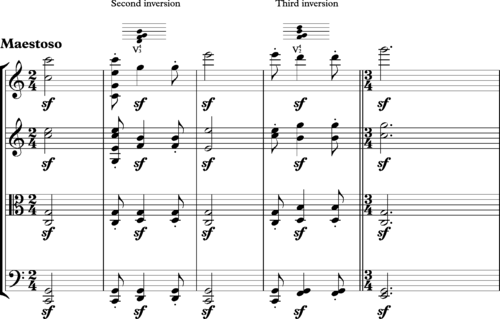Dominant seventh chord
The clashing sound produced by playing these two notes together gives the dominant seventh chord its dissonant quality (i.e. its harmonic instability).The V7 chord is found almost as often as the V, the dominant triad,[5] and typically functions to drive the piece strongly toward a resolution to the tonic of the key.In it, a dominant seventh chord (in red) is handled conservatively, "prepared and resolved as a suspension, clearly indicating its dissonant status.In the Romantic period, freer voice-leading was gradually developed, leading to the waning of functional use in the post-Romantic and Impressionistic periods including more dissonant dominant chords through higher extensions and lessened use of the major minor chord's dominant function.The opening bars of Mozart’s Piano Sonata in C, K545 features dominant seventh chords in both second and first inversions:The concluding cadence of the same movement features the chord in root position:A striking use of inversions of the dominant seventh can be found in this passage from the first movement of Beethoven’s String Quartet Op.Examples include Bill Haley and the Comets' "Rock Around the Clock" and Buster Brown's "Fanny Mae", while in Chuck Berry's "Back in the U.S.A." and Loggins and Messina's "Your Mama Don't Dance" the tonic chord is also a dominant seventh.[15] Used mostly in the first fifteen years of the rock era and now sounding somewhat "retrospective" (e.g., Oasis' "Roll With It"), other examples of tonic dominant seventh chords include Little Richard's "Lucille", The Beatles' "I Saw Her Standing There", Nilsson's "Coconut", Jim Croce's "You Don't Mess Around With Jim", and The Drifters' "On Broadway".




minor seventhperfect fifthmajor thirdTuning4:5:6:736:45:54:64Forte no.Complementmusic theoryseventh chordmajor triaddenotedleading notesubdominant notetritoneharmonicfifth scale degreeRoman numeral analysisclassical musicdominant triadfunctionsresolutionRenaissance composersintervalschordsdissonantMonteverdipreparationBaroque composerssuspensionClassical periodRomantic periodvoice-leadingpost-RomanticImpressionistic periodsextensionsTwentieth-century classical musicfunctional harmonypopular musicsChopinMazurka in F minor (1849), Op. 68MozartPiano Sonata in C, K545cadenceBeethoven String Quartet Op. 127Piano Sonata in B♭ major, Op. 22functionresolveintervalleading-tonedeceptive cadencecircle progressionsupertonicchromaticmodulatesecondary dominantextended dominantsubstitute dominantcommon practicevoice leadingdiminished fifthaugmented fourthstepwiseHeinrich Schenkerpassing notepopular musicblues progressionBill Haley and the CometsRock Around the ClockBuster BrownFanny MaeChuck BerryBack in the U.S.A.Loggins and MessinaYour Mama Don't DanceRoll With ItLittle RichardLucilleThe BeatlesI Saw Her Standing ThereNilssonCoconutJim CroceYou Don't Mess Around With JimThe DriftersOn BroadwayRock and Roll Musicenharmonically equivalentseptimal quarter toneharmonic seventh chordjust tuning5-limitbarbershop quartetsBarbershop Harmony Societyscale degreejust intonationovertonesbarbershop seventh chordNotationHarmonic seventhPythagorean minor seventhIrregular resolutionNondominant seventh chordSubtonicMixolydian modeForte, AllenGoldman, Richard FrancoSchenker, HeinrichJonas, OswaldDegreesdiatonic scaleMediant[D](Sp)SubdominantDominantSubmediantLeading toneAugmentedDiminishedSuspendedSeventhDominant seventh flat fiveHalf-diminishedDiminished majorMinor-major